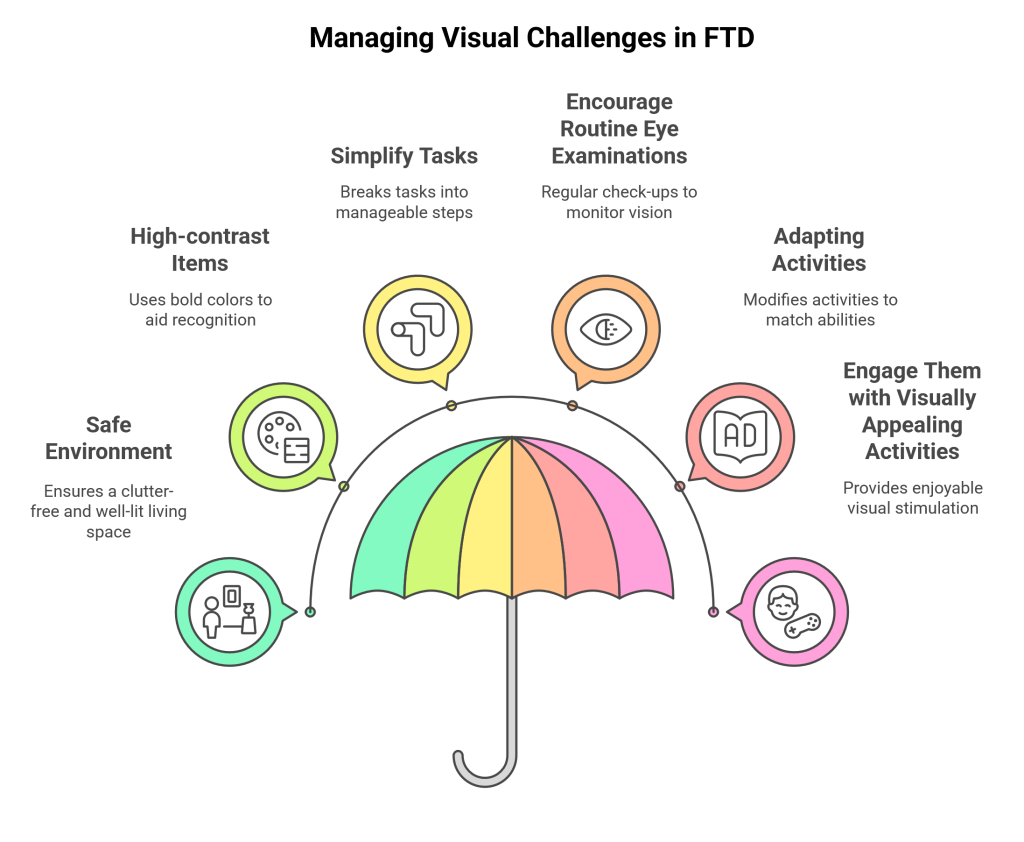When we think of dementia, memory loss or cognitive decline comes into our minds first. But it is proven that dementia can also cause a lot of eye-related problems in patients. In particular, Frontotemporal Dementia, also known as FTD, primarily impacts a person’s brain’s frontal and temporal lobes. However, due to severe health conditions and improper lifestyle, FTD can also impact dementia patient’s vision, eye movement, and how their brain processes visual information.
In this blog, we are going to talk about different vision issues a person faces due to FTD and how it can impact caregiving efforts. Being aware of this information on Frontotemporal Dementia Eyes will save you and your loved one from wasting unnecessary money on antipsychotic medications and finding the right cure for it. Let’s start!
What is Frontotemporal Dementia?
Frontotemporal dementia mainly affects the frontal and temporal sides of the brain. It creates changes in behavior, language, and emotion. Slowly, the parts of the lobes begin to shrink, and your loved ones become impulsive. They have difficulty finding the right words or comprehending complex sentences. While FTD significantly affects cognitive function, it can also impact physical aspects, such as eye movement and coordination.
How does Frontotemporal Dementia Affect the Vision of an Individual?
There is a great deal of variability in vision problems in Frontotemporal Dementia. Some people can have very specific symptoms of problems with their vision, whereas others have very non-specific issues. Following are ways FTD might affect the eyes:
- Difficulty in Ocular Movement: FTD can affect the brain’s signals to control the eye’s movement. A patient may thus find it hard to track a moving object across a room or to shift their eye focus from one place to another.
- Changes in Visual Perception: FTD patients may perceive visual information differently. For instance, they may show difficulties in recognizing faces or objects. This is perplexing and may lead to difficulties in spatial orientation.
- Problems with Visual Memory: It can affect the ability to remember visual details. This means that one may have difficulties in recalling what they have seen or recognizing familiar places and faces.
- Altered Visual Attention: Patients with FTD exhibit problems maintaining attention to visual tasks. They may have a hard time paying attention while reading books, watching television, or even recognizing things around them.
- Altered Sensitivity to Light: Some patients with FTD develop sensitivity to light. Bright lights may then be irritating or make it harder for them to see clearly.
Why Our Vision Change Because of FTD?
The FTD normally affects those portions of the brain involved in processing and interpreting visual input. The frontal lobes, for instance, are responsible for actions that regulate eye movement and focusing. They participate in maintaining visual memory and attention. Damage to these areas caused by FTD may lead to the above-mentioned visual problems.
Recognizing Visual Problems
It is tough to identify a visual disorder in a person with FTD. Sometimes, it may be terribly subtle and, hence, not immediately evident. Following are some signs indicating that a person might have a problem with his or her vision:
- Difficulty Performing Activities: Difficulty in reading or watching TV, trouble locating items, and difficulty performing other tasks involving vision may warrant close attention.
- Avoiding Eye Contact: A person who has trouble with visual processing may avoid looking directly at people or objects.
- Difficulty Getting Around: Not being able to get around his or her home or not seeming to recognize familiar places may be the result of a problem with his or her vision.
- Changes in Behavior: A person who is confused or frustrated may result because of their fight with poor vision.
Strategies that help address Vision Problems
If you notice any of these signs, here are some ways that might help the person manage his or her FTD-related visual problems:
- Safe Environment: A person with FTD should be assured of the safest and easiest environment in which to live. Eliminate clutter and ensure that pathways are free. Good lighting can also facilitate the process of seeing things around them clearly.
- High-contrast items: High-contrasting colors and patterns may make it easy for a person living with FTD to recognize things that surround them and navigate through an environment.
- Simplify Tasks: Activities may be broken down into smaller steps and explained clearly. It often helps the person with Dementia manage task difficulties.
- Encourage Routine Eye Examination: Frequent eye examinations may trace out any defect in vision and treat it accordingly. An ophthalmologist may give advice related to managing particular visual problems of FTD.
- Adapting Activities: Adapt the activities that suit current abilities. For example, audiobooks or large-print material can be used for those who find it difficult to read.
- Engage Them with Something Visually Appealing: Visual stimulation can be given by engaging them in something that gives them some kind of enjoyment through their vision. This can include some easy games that involve visual skills and may prove to be helpful as well as entertaining.
Apart from this, you should read this blog to learn when it’s time for in-home dementia care for your loved ones.
How to Get Professional Help?
If one suspects that problems with vision are affecting someone with FTD, professional advice should be taken soon. An ophthalmologist will be able to determine whether problems are specific and recommend interventions if appropriate. A neurologist with experience of FTD would offer an opinion on how the disease impacts the state of visual function.
- Emotional and Practical Support: Changes in vision can be very difficult for the person with FTD and their caregivers. Therefore, providing emotional support at this time is important to make them feel supported. You should let them know that it is okay to open up about their experiences and challenges.
- Support Groups and Resources: The individuals should attend support groups regarding FTD. It will be informative and emotionally rewarding to the individuals as they will be comfortable sharing experiences with others facing similar challenges. Additionally, an assisted living facility can offer significant assistance, ensuring a supportive environment tailored to their needs. Learn more about benefits offered by assisted living facilities.
Conclusion
FTD can impact nearly everything in life, even vision. Understanding how FTD affects the eyes will help family members and caregivers know how to support their loved ones. The more likely signs of the emergence of visual problems and strategies to deal with them will significantly improve the quality of life for a person diagnosed with FTD.
Above all, it is possible to overcome the challenges related to vision by taking professional advice from Oakdale Heights assisted living facility in California. In time, with forbearance and understanding backed up with the right assistance, you will find that your loved one may sort through the challenges of FTD and live a good quality life.







